Locations of crimes
- Details
- Written by: УМ
- Parent Category: Croatia
- Category: Šibenik
- Hits: 54
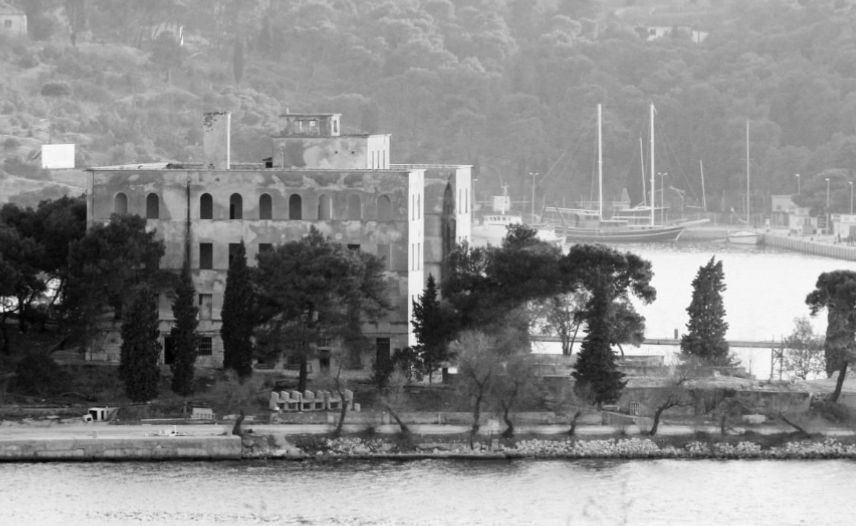
One of the also notorious Croatian camps for Serbs during the last war, about which the media remain silent, is the Kuline camp in Šibenik, which, in terms of methods of torture and brutal killings, was no different from the Lora camp in Split. People sent to the Kuline camp were mostly local Serbs from the areas of Šibenik, Drniš, and Benkovac, including both men and women equally.
In Kuline, Serbs were killed by having their heads smashed against walls, subjected to electric shocks, and having their throats pierced with metal rods. One of the specific atrocities of this camp was the method of raping Serbian women using specially trained dogs. Serbian woman Marija Klisurić from the village of Miljevci near Drniš, after being raped by dogs, committed suicide.
Read more: Kuline – a camp of suffering for the Serbian people during the Homeland War
- Details
- Written by: УМ
- Parent Category: Kordun
- Category: Klupice
- Hits: 34
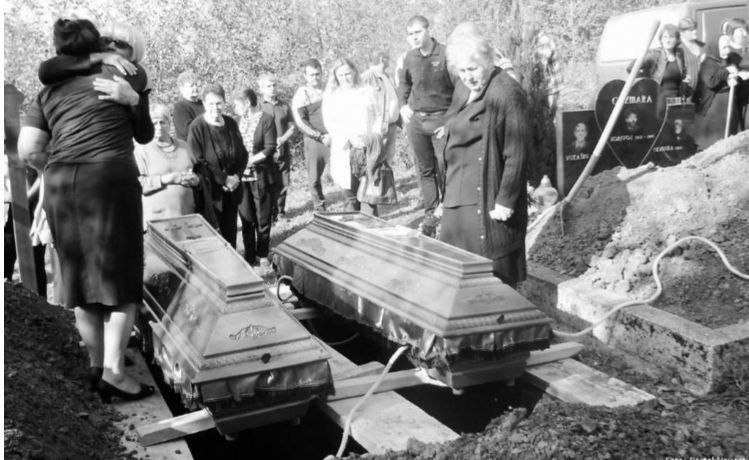 The village of Klupice, in the municipality of Vojnić in the area of historic Kordun in Croatia, was the site of tragic events during the 1991–1995 war. During Operation “Storm,” 24 Serbian civilians who had not left the village were killed, 23 of whom were buried immediately, while one victim was identified later. This massacre is part of the broader suffering of Serbs in Kordun and stands as a symbol of the war’s impact on local communities.
The village of Klupice, in the municipality of Vojnić in the area of historic Kordun in Croatia, was the site of tragic events during the 1991–1995 war. During Operation “Storm,” 24 Serbian civilians who had not left the village were killed, 23 of whom were buried immediately, while one victim was identified later. This massacre is part of the broader suffering of Serbs in Kordun and stands as a symbol of the war’s impact on local communities.
Read more: War crime in Klupice – civilians killed during Operation “Storm”
- Details
- Written by: УМ
- Parent Category: Virovitica-Podravina County
- Category: Virovitica
- Hits: 16
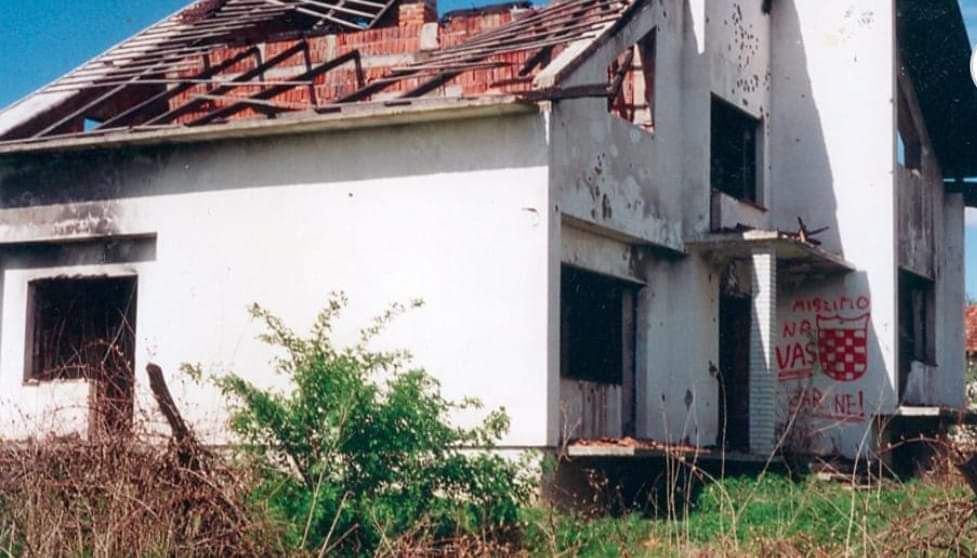 At the end of 1991, in the area of Western Slavonia, some of the most tragic events of the Croatian War took place. The military operation known as “Orkan ’91” aimed at achieving military victories over the Yugoslav People’s Army and the Serbian Territorial Defense, but it also led to the systematic persecution of the Serbian population in the Virovitica region. According to numerous reports and historical analyses, more than twenty villages were subjected to ethnic cleansing, and thousands of Serbs were forced to leave their homes, often under threat or direct violence. These events represent an important and painful chapter in the region’s history, highlighting the complexity of the conflict and the profound consequences that war leaves on the local population.
At the end of 1991, in the area of Western Slavonia, some of the most tragic events of the Croatian War took place. The military operation known as “Orkan ’91” aimed at achieving military victories over the Yugoslav People’s Army and the Serbian Territorial Defense, but it also led to the systematic persecution of the Serbian population in the Virovitica region. According to numerous reports and historical analyses, more than twenty villages were subjected to ethnic cleansing, and thousands of Serbs were forced to leave their homes, often under threat or direct violence. These events represent an important and painful chapter in the region’s history, highlighting the complexity of the conflict and the profound consequences that war leaves on the local population.
Read more: "Ethnic cleansing of Serbs from Virovitica during 'Orkan'
- Details
- Written by: SH
- Parent Category: Locations of crimes
- Category: North Macedonia
- Hits: 56
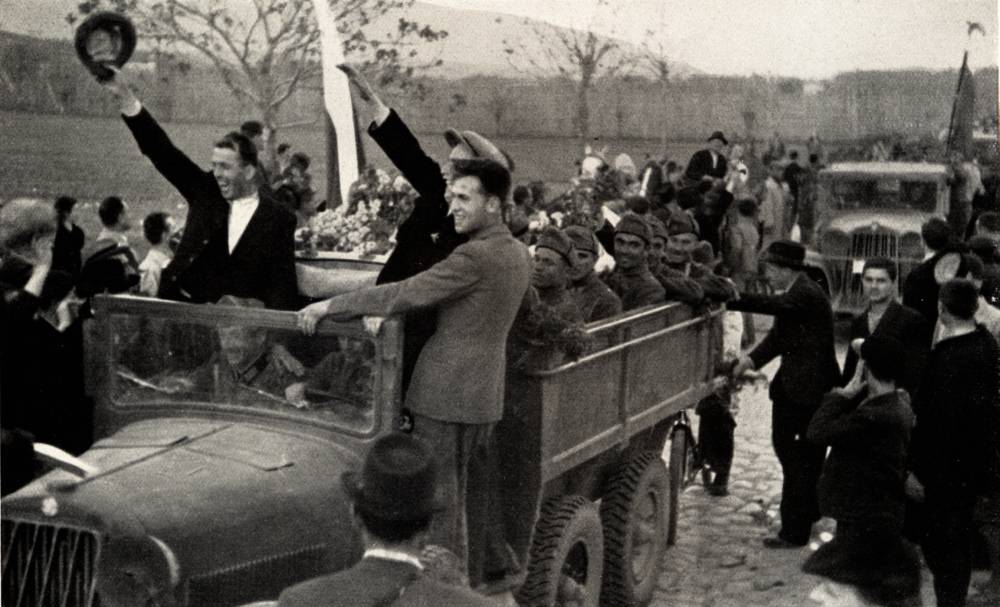
Catena mundi reveals: How the Macedonians treated Serbs in 1941. A harrowing testimony of two Serbian priests.
1. Živojin B. Spasić, a priest from the Leskovac parish, Štip district, Vardar Banovina. I escaped on April 7, 1941
2. I left the Leskovac parish because the Macedonians were preparing to kill us Serbs as soon as our army abandoned its positions and the occupiers took over.
I fled towards the Greek border, but the retreat path was cut off, so we returned to Kavadar on April 9, 1941. In Kavadar, I read a Macedonian proclamation, where the leaders called on people to cleanse Macedonia of Serbs, going so far as to spare neither women nor children. I left Kavadar on April 10 and was already in Sv. Nikola, Ovče Polje district, by April 12. There, I planned to gather information on what to do—whether to return to the parish or continue my journey to old Serbia.
- Details
- Written by: SH
- Parent Category: North Macedonia
- Category: Kumanovo
- Hits: 62
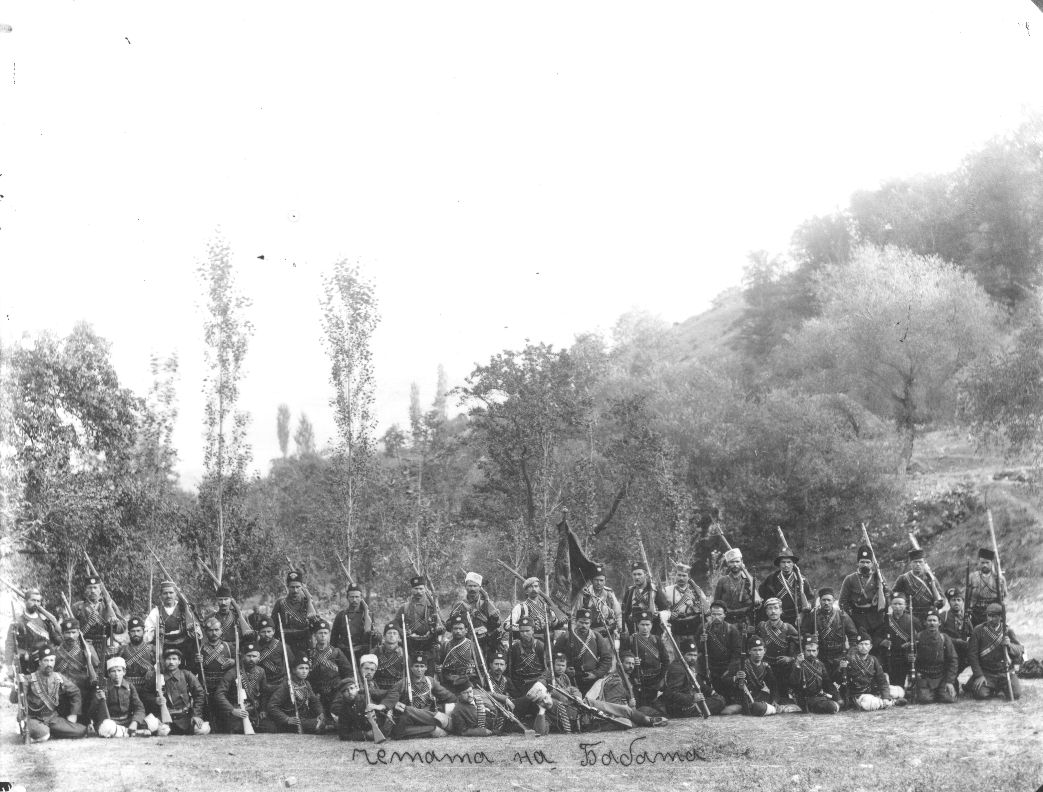 The Kokoshin Massacre is a term used to describe the most brutal crimes committed by VMRO komitadjis against Serbs in Macedonia, or Old Serbia, as this region was known in Serbia at the time. The term Kokoshin massacre refers to several crimes carried out by VMRO komitadjis in the vicinity of Kumanovo and Kratovo during the period from July to October 1904. These crimes were committed by VMRO units under the command of voivodes Atanas Babata and Jordan Spasov. The collective name Kokoshin massacre was given by the Serbian press for the murders in the villages of Kokoshin, Shopski Rudar, and Tatomir, as Kokoshin suffered the greatest number of victims.
The Kokoshin Massacre is a term used to describe the most brutal crimes committed by VMRO komitadjis against Serbs in Macedonia, or Old Serbia, as this region was known in Serbia at the time. The term Kokoshin massacre refers to several crimes carried out by VMRO komitadjis in the vicinity of Kumanovo and Kratovo during the period from July to October 1904. These crimes were committed by VMRO units under the command of voivodes Atanas Babata and Jordan Spasov. The collective name Kokoshin massacre was given by the Serbian press for the murders in the villages of Kokoshin, Shopski Rudar, and Tatomir, as Kokoshin suffered the greatest number of victims.
Massacres
The first killings of Serbs began in the village of German, located at the tri-border area of the Kumanovo, Krivopalanka, and Presevo districts. The village was patriarchal, meaning Serbian, and the VMRO units saw it as a thorn in their side because they feared that Serbian units could establish a base there from which they could threaten the channels of VMRO units traveling from Bulgaria to the interior of the Ottoman Empire. On May 12, 1904, the komitadjis attacked the house of Jovcha Spasic, the father of the village Serbian teacher Dimitrije Jovanovic. Jovcha was not at home at the time, but the komitadjis slaughtered his brother Kitan, his son Stosha, his daughters-in-law Anica and Todora, and his son-in-law Karanfil with knives, while his wife Milja was wounded with eight stab wounds.[1]
- Details
- Written by: SH
- Parent Category: Locations of crimes
- Category: Greece
- Hits: 54
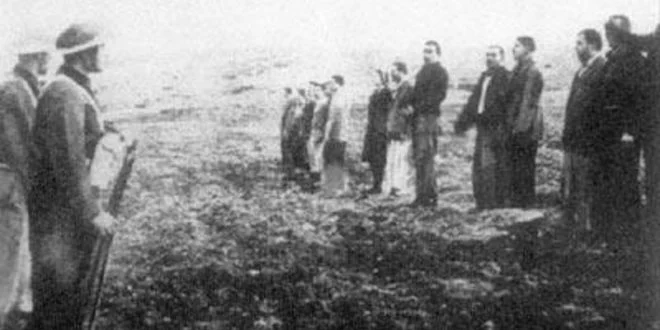 Images of Massacres – Genocide Against Serb Macedonians in the Aegean Macedonia Region.
Images of Massacres – Genocide Against Serb Macedonians in the Aegean Macedonia Region.
Before 1878, there were almost no Greeks here. According to the 1912 census, Greeks were a minority throughout Aegean Macedonia, even in Thessaloniki itself.
Forgotten Greek crimes against the indigenous Serb population during the civil war from 1946 to 1949. This was the final phase of the ethnic cleansing of Serbs in Aegean Macedonia, who have lived in this area for millennia.
The crimes occurred during the communist uprising against the Greek government.
History of the population census:
Read more: How the Ethnic Cleansing of Serbs in Aegean Macedonia Was Carried Out
- Details
- Written by: SH
- Parent Category: Kosovo and Metohija
- Category: Gjakova
- Hits: 74
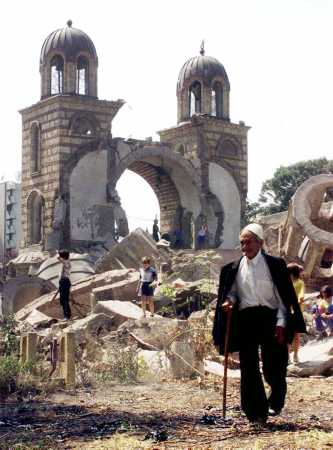 The old Church of the Holy Trinity in the city of Đakovica was intended to be a mausoleum, a memorial ossuary for thousands of Serbian children who died in Albania, as well as for the earthly remains of those who perished, were killed, or froze during the wars of 1912–1918.
The old Church of the Holy Trinity in the city of Đakovica was intended to be a mausoleum, a memorial ossuary for thousands of Serbian children who died in Albania, as well as for the earthly remains of those who perished, were killed, or froze during the wars of 1912–1918.
This church was completed in 1940, but the April War of 1941 prevented its final completion and consecration. It was destroyed by Serbian godless communists in 1949 (blown up) on Savindan (January 27).
Its destruction was one of the most drastic examples of political antitheism by the new authorities established immediately after the end of World War II (as noted in the letter from the Bishop of Raška and Prizren, Mr. Vladimir, to the Serbian Patriarch Mr. Vikentije, “Destruction of the Church in Đakovica,” dated June 28, 1951, in: Endowments of Kosovo, pp. 803–804).
- Details
- Written by: УМ
- Parent Category: Kosovo and Metohija
- Category: Lipljan
- Hits: 46
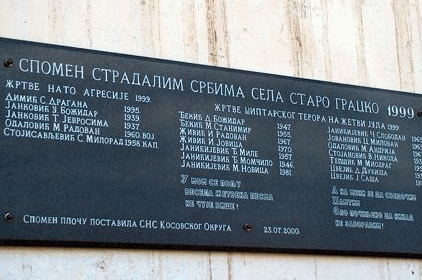
On July 23, 1999, in the village of Staro Gracko near Lipljan, fourteen Serbs were brutally murdered in a field. A burst of gunfire, fired at close range, cut down fourteen men, and some families from this village lost all of their male members in a matter of moments.
The Kosovo authorities, UNMIK, EULEX, and KFOR failed to find the killers of the Serbian harvesters from Staro Gracko even after fourteen years.
The youngest of the murdered was only seventeen years old.
The victims were:
Subcategories
Locations of crimes Article Count: 24
Places of crimes against the Serbian people. Current states, cities, settlements, villages, towns, regions, etc.
Bosnia and Herzegovina Article Count: 1
Bosnia and Herzegovina (abbreviated BiH), informally Bosnia, a country in Southeastern Europe which is located on the Balkan Peninsula. It borders Serbia to the east, Montenegroin the southeast and Croatia in the north and southwest. In the south, it has access to the Adriatic Sea. The northern and larger part of the country is occupied by the region of Bosnia, and the southern and smaller part by the region of Herzegovina. The capital and largest city is Sarajevo. The place of crimes against Serbs.
Federation of Bosnia and Herzegovina Article Count: 1
The Federation of Bosnia and Herzegovina is one of the two entities in Bosnia and Herzegovina, in addition to the Republika Srpska. It occupies about 51% of the territory of Bosnia and Herzegovina. It was founded on March 18, 1994, with the signing of the Washington Agreement, which ended the Muslim-Croat conflict. The capital is Sarajevo, along with Mostar, where the headquarters of four federal ministries are located. With the latest constitutional changes, the Serbs also became a constituent nation of the Federation, so that currently there is a declarative constitution of all three nations in the entire territory of the Federation. The place of crimes against Serbs.
Zenica Article Count: 1
Zenica - a city, the administrative and economic center of the Zenica-Doboj canton and the local self-government unit of the same name in the Federation of BiH (Bosnia and Herzegovina). It is located in the valley of the Bosna River, about 70 km northwest of Sarajevo. The city is known for its ironworks and other heavy industry, but also as an important university center. The place of crimes against Serbs.
Montenegro Article Count: 1
Montenegro is a country in Southeast Europe, located on the Balkan Peninsula. It borders Bosnia and Herzegovina in the northwest, Serbia in the east, Albania in the southeast and Croatia in the west, while in the southwest it has a coast along the Adriatic Sea. The place of crimes against Serbs.
Plav Article Count: 1
Plav is a city and seat of the municipality of the same name in the east of Montenegro. According to the 2023 census, there were 4,121 inhabitants. It is located at the foot of the Prokletije mountain massif, on the river Lim. The place of crimes against Serbs.
Croatia Article Count: 6
Croatia, officially the Republic of Croatia, is a country in Central and Southeastern Europe, on the coast of the Adriatic Sea. It borders Slovenia in the northwest, Hungary in the northeast, Serbia in the east, Bosnia and Herzegovina and Montenegro in the southeast, and Italy in the west. Place of crime against Serbs!
Zagreb Article Count: 2
Zagreb is the capital and largest city of Croatia. It is located in the north of the country, along the Sava river, on the southern slopes of the Medvednica mountain. Zagreb is located near the international border between Croatia and Slovenia. Place of crime against Serbs!
Split Article Count: 1
Split in older texts also written as Spalato or Splet — is the second-largest city in Croatia and the administrative center of Split-Dalmatia County. According to the 2021 census, it had 149,830 inhabitants. As the largest city in Dalmatia and an important historical and cultural center of Croatia, it has been included on the UNESCO World Heritage List.
Šibenik Article Count: 1
Šibenik is a city in Croatia and the administrative center of Šibenik-Knin County. According to the 2021 census, the city had a population of 42,599, while the settlement itself had 31,115 inhabitants. It is located in central Dalmatia, at the mouth of the Krka River into the Adriatic Sea.
Kordun Article Count: 1
Kordun (Croatian: Kordun) is a geographical and historical region that covers the area between Petrova Gora and the Mrežnica River in present-day Croatia. Between 1990 and 1995, Kordun was part of the SAO Krajina and the Republic of Serbian Krajina.
Klupice Article Count: 1
The village of Klupice is located in the Vojnić municipality, in the historical and geographical region of Kordun in Croatia, between Petrova Gora and the Mrežnica River. Before the war of 1991–1995, the village had a predominantly Serbian population and was part of the broader Kordun region, an area with a rich history and significance in the context of the Serbian community in Croatia.
Virovitica-Podravina County Article Count: 1
Virovitica-Podravina County is located in northern Croatia. It is situated in the Podravina region in northern Slavonia, with its administrative center in Virovitica. It borders Požega-Slavonia County to the south, Koprivnica-Križevci County and Bjelovar-Bilogora County to the west, and Osijek-Baranja County to the east. According to preliminary results of the 2021 census, the county had a population of 70,660.
Virovitica Article Count: 1
Virovitica is a city in Croatia and the administrative center of Virovitica-Podravina County. According to the 2011 census, the city had a population of 21,291, while the urban settlement itself had 14,688 inhabitants.
North Macedonia Article Count: 2
North Macedonia, officially the Republic of North Macedonia (formerly SR Macedonia and Old Serbia), is a country in Southeastern Europe. It borders Greece to the south, Albania to the west, Bulgaria to the east and Serbia to the north. It occupies approximately one third of the territory of the larger geographical region of Macedonia. The capital and largest city is Skopje.
Kumanovo Article Count: 1
Kumanovo is the second largest city in North Macedonia, after Skopje. It is the seat of the municipality of the same name, as well as the main urban settlement of the Northeast Statistical Area within the state. It is located in the northeastern part of North Macedonia at an altitude of 333 m.
Greece Article Count: 1
Greece, officially the Republic of Greece, is a country in Southeastern Europe. It is located in the Balkans, between the Aegean Sea to the east, the Ionian Sea to the west and the Mediterranean Sea to the south. It borders Albania to the northwest, North Macedonia and Bulgaria to the north, and Turkey to the northeast. Place of crime against Serbs!
Serbia Article Count: 11
Serbia, officially the Republic of Serbia, is a country in Central and Southeastern Europe. It occupies most of the Balkan Peninsula and a smaller part of the Pannonian Plain. It borders Hungary to the north, Romania to the northeast, Bulgaria to the east, North Macedonia to the south, Albania and Montenegro to the southwest, and Bosnia and Herzegovina and Croatia to the west. It has a population of about eight million. The capital and largest city is Belgrade, which is among the oldest and largest cities in Southeastern Europe. The official language is Serbian, and the official currency is the Serbian dinar.
Kosovo and Metohija Article Count: 10
Косово и Метохија — скраћено КиМ, званично Аутономна Покрајина Косово и Метохија — АПКиМ, понекад кратко Косово, или Космет (од Косово и Метохија), је аутономна покрајина у саставу Србије. Налази се у средишту Балканског полуострва, а чине је области Косово и Метохија. Граничи се на југоистоку са Северном Македонијом, на југозападу са Албанијом и на западу са Црном Гором. Према попису из 2024. било је 1.586.659 становника. Службени језици су српски и албански, а седиште администрације се налази у Приштини.
Gjakova Article Count: 1
Đakovica is an urban settlement and the seat of the municipality of the same name in Serbia, located in the southwestern part of Kosovo and Metohija and belonging to the Peć Administrative District. According to the 2024 census, there were 41,809 inhabitants. It is located in the west of Metohija, between Peć and Prizren, while it is about 100 km from the Adriatic Sea coast.
Lipljan Article Count: 2
Lipljan is an urban settlement and the administrative center of the municipality of the same name in Serbia, located in the central part of Kosovo and Metohija, and it belongs to the Kosovo administrative district. According to the 2024 census, it had 13,092 inhabitants. It is situated 16 km south of Priština, at the confluence of the Janjevka River with the Sitnica River, and lies on the main route connecting Priština with Skopje and Prizren.
Lipljan in Kosovo and Metohija a site of suffering for Serbs
Peć Article Count: 1
Peć is an urban settlement and the administrative center of the municipality of the same name in Serbia, located in the western part of Kosovo and Metohija. It belongs to the Peć administrative district. According to the 2024 census, it had 41,171 inhabitants.
The town is situated on the Peć Bistrica River, a tributary of the White Drin, near the Prokletije mountains to the east. The Rugova Gorge, one of the longest and deepest gorges in Europe, is located about three kilometers from the city of Peć.
The city is 250 km north of Tirana, 150 km northwest of Skopje, and 280 km from Podgorica.
In the Middle Ages, the city was the seat of the Serbian Orthodox Church from the 13th century. The Peć Patriarchate Monastery is part of UNESCO's World Heritage site of Medieval Monuments in Kosovo
Camps Article Count: 1
Camps in which Serbs suffered
First world war Article Count: 0
Camps in the First World War where Serbs suffered
Kosovo Field Article Count: 1
The Municipality of Kosovo Polje is a municipality in the Republic of Serbia, located in the Autonomous Province of Kosovo and Metohija, and is part of the Kosovo Administrative District.
The municipality covers an area of 89 km².
This municipality, together with the municipalities of Obilić and Novo Brdo, was established on July 2, 1988, from settlements that were previously part of the then Municipality of Priština (Official Gazette of the SAP of Kosovo, no. 18/88).
Orahovac Article Count: 1
Orahovac is an urban settlement and the administrative center of the municipality of the same name in Serbia, located in the southwestern part of Kosovo and Metohija, and belonging to the Prizren Administrative District. According to the 2024 census, it had a population of 13,642.
The settlement's territory lies within the cadastral municipality of Orahovac, covering an area of 4,894 hectares.
Gnjilane Article Count: 1
Gjilan (Albanian: Gjilan or Gjilani) is an urban settlement and the administrative center of the municipality of the same name in Serbia, located in the southeastern part of Kosovo and Metohija. It is the seat of the Kosovo Pomoravlje administrative district. According to the 2024 census, it had a population of 53,279. Gjilan is situated in the Kosovo Pomoravlje region and is connected to Pristina, Uroševac, Kosovo Kamenica, Preševo, and Bujanovac.
Prizren Article Count: 1
Prizren is an urban settlement and the administrative center of the municipality of the same name in Serbia, located in the southern part of Kosovo and Metohija, and belongs to the Prizren administrative district. According to the 2024 census, it had 76,850 inhabitants. It is one of the most important cities of the medieval Serbian state and cultural heritage of Serbia. The city is situated at the foothills of the Šar Mountains, near the borders with Albania and North Macedonia.
Ribe Article Count: 1
The village of Ribe (Ribe) is a small, remote mountain settlement located in the Mat district in northern Albania, not far from the town of Burrel. This village gained international, and extremely tragic, notoriety after the Kosovo war in 1999, as it was allegedly the site of the so-called "Yellow House."
Bogatić Article Count: 1
Bogatić is a settlement in Serbia and the administrative center of the municipality of the same name in the Mačva District. It is located 98 km west of Belgrade. According to the 2022 census, it had a population of 5,569. The inhabitants of Bogatić are called Bogatinci.
Glušac Article Count: 1
Glušci is a village in Serbia, located in the municipality of Bogatić, in the Mačva District. According to the 2022 census, it had a population of 1,635. To the west, it borders Bogatić and Radenković; to the north, Noćaj; to the east, Uzveće; and to the south, Mačvanski Metković. Glušci are connected by paved roads to Mačvanska Mitrovica, Šabac, and Bogatić.
Bulgaria Article Count: 1
The Republic of Bulgaria is a country in Southeastern Europe. It borders Romania to the north, Serbia and North Macedonia to the west, Greece and Turkey to the south, and the Black Sea to the east. With a territory of 110,994 km2, Bulgaria is the 16th largest European country. According to the 2022 estimate of the National Institute of Statistics, the Republic of Bulgaria has a population of 6,447,710.
Sliven Article Count: 1
Sliven is a city in the Republic of Bulgaria, in the central part of the country. The city is also the seat of the eponymous Sliven region. The town of Sliven was once known to the Bulgarian people as the center of the Hajduchy during the Ottoman rule, so it was nicknamed the "City of 100 Dukes".




